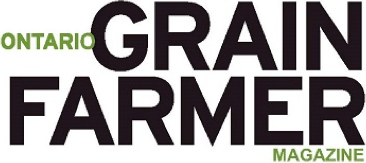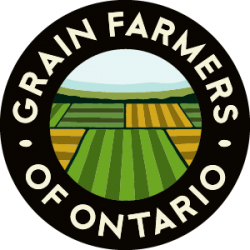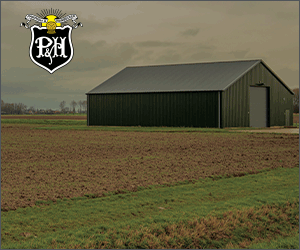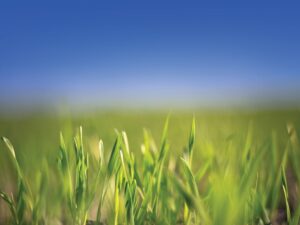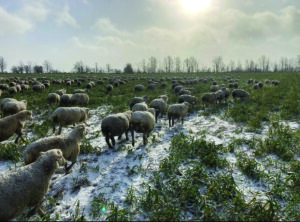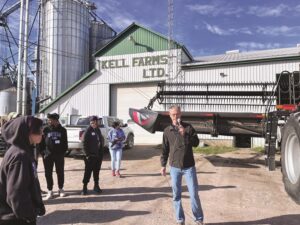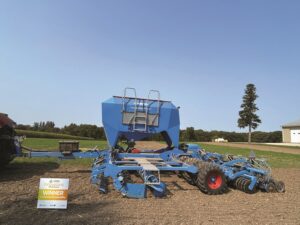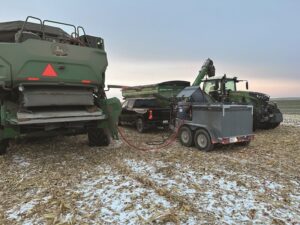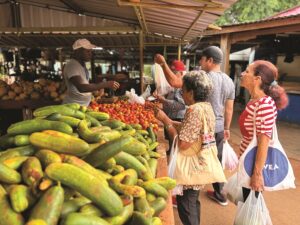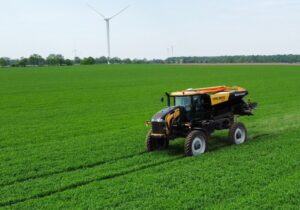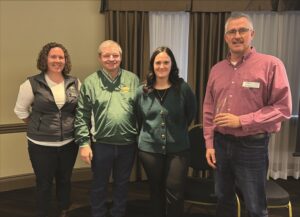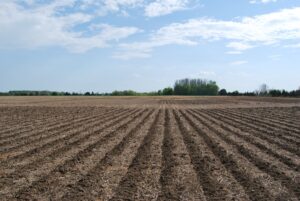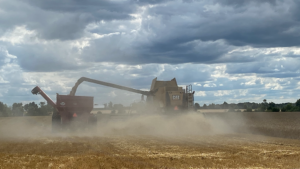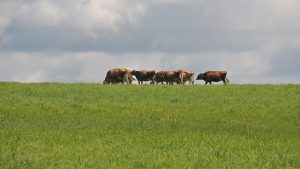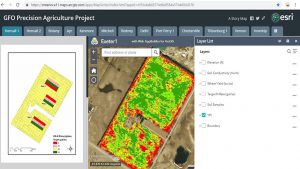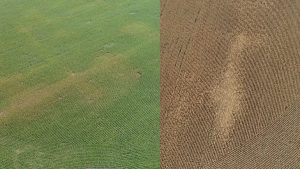Preventing DON in corn
BEST MANAGEMENT TIPS FOR 2019
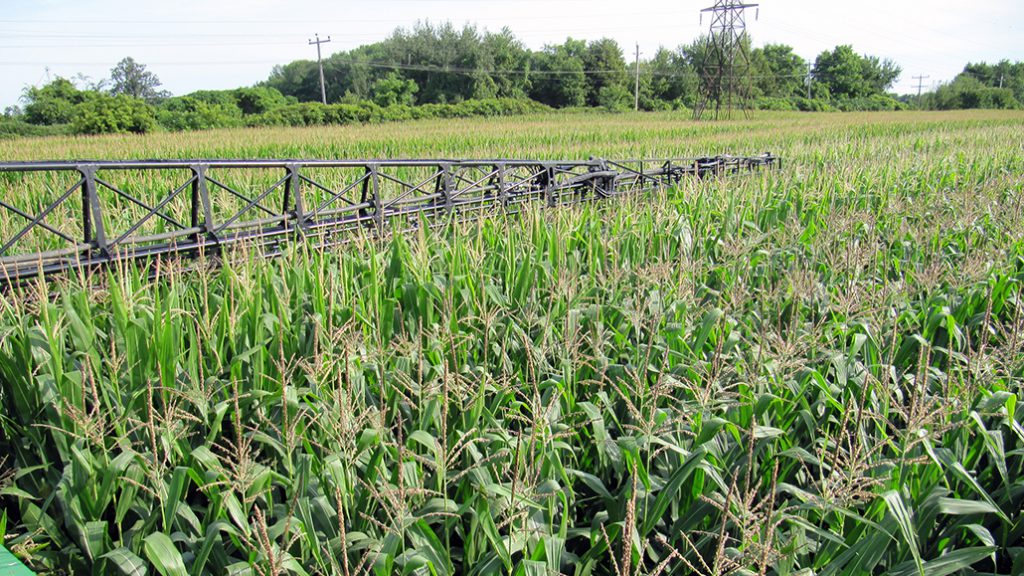
MORE THAN TWO million acres of corn were planted in Ontario in 2018 and yields were reported to be above average at 181 bushels/acre. But it wasn’t a profitable crop for many farmers. High levels of DON, particularly in southwestern Ontario, led to high discounts and outright rejections at the point of delivery. Grain Farmers of Ontario estimates a $200 million loss could be amongst affected farmer-members.
DON is a mycotoxin produced primarily by Gibberella ear rot. Weather conditions during the latter half of the 2018 growing season were favourable for the development of the mould and subsequent DON production. Rainfall, humidity, lingering dews, foggy mornings, temperature, and hybrids all factored in to the severity of the problem. Wet conditions also delayed harvest, which increased secondary infections.
PREVENTION STRATEGIES
Farmers can’t control the weather — so those planting corn this year will need to focus on what they can control to reduce the potential for losses. Severe infections of ear moulds can impact yields as well as the quality of the grain. According to Albert Tenuta, field crop plant pathologist at the Ontario Ministry of Agriculture, Food and Rural Affairs, the best prevention strategy is ‘resistance plus fungicide’.
“Hybrids play an important factor in disease development and DON as well,” says Tenuta. “There are some hybrids that regardless of the disease pressure consistently show higher resistance/tolerance.”
Part of the problem with the 2018 crop was the majority of acres in some areas were planted to a highly susceptible hybrid and some farmers only planted one variety. Planting hybrids with resistance to ear rots will help reduce your risk and it’s important to use multiple hybrids to further mitigate potential problems with a severe disease outbreak.
Research conducted in Ridgetown has shown that Proline and Caramba fungicides are the most effective options for reducing DON levels. Tenuta notes that it is important to understand the difference in targeting your fungicide for leaf diseases or ear rots. It’s also important to note that fungicides do not provide complete protection against ear moulds, but proper applications have been shown to provide suppression.
Spraying at silking, when silks are fully emerged, is recommended. Silk channel infection by Gibberella occurs two to six days after silking and symptoms will start to appear two to three weeks following infection. Two to four days of wet conditions during silking will increase the severity of the infection.
While the majority of infections in 2018 were through the silk channel, kernel wounds can also be a source for disease growth. Managing western bean cutworm will help reduce the number of wounds open to infection.
“A lot of the management techniques we are using to increase yield are also creating more favourable environments for disease development,” says Tenuta.
This includes, faster growing plants, higher plant populations, and hybrids that create bushier plants or weaker stalks.
Residues, cover crops, and minimum tillage also play a role in the spread of diseases that overwinter on residue (such as Gibberella), which is why soil management and crop rotation also play an important role in reducing your risk of a second year of disease infection.
If you do have a problem with Gibberrella, harvesting as soon as possible will help prevent further infection. However, as farmers experienced in 2018, that isn’t always possible. In that case, keeping infected grain separate is important to keep your marketing options open.
Farmers looking for additional corn and disease management tips can reference Field Crop News http://fieldcropnews.com/ or the Crop Protection Network (https://cropprotectionnetwork.org/).
IDENTIFYING GIBBERELLA EAR ROT
Gibberella ear rot is the most common and important ear mould in Ontario. Infection often begins at the ear tip and moves down towards the ear base. In severe cases, the ear husk and cob fuse — resulting in mummified ears. Although the fungus can produce a white-coloured mould which makes it difficult to tell apart from Fusarium Ear Rot, Gibberella produces a characteristic dark red or pink coloured mould. Toxins produced by Gibberella include Deoxynivalenol (vomitoxin or DON), Zearalenone (ZEN) and T-2 toxin. •
WHAT YOU NEED TO KNOW
|
DON ACTION ITEMS UPDATE – GRAIN FARMERS OF ONTARIO
SAMPLE TESTING PROTOCOL RESEARCH
A MYCOTOXIN RESEARCH Coalition, which includes Grain Farmers of Ontario, the Ontario Ministry of Agriculture, Food and Rural Affairs, the Ontario Agri-Business Association, and the University of Guelph, was established in response to the increased levels of DON in the 2018 corn crop.
A primary initiative of this coalition is research led by Dr. Art Schaafsma, University of Guelph Ridgetown Campus, on sample testing protocols. A significant problem for farmers attempting to make deliveries at harvest time was the inconsistent DON test results they received on some loads of corn at different elevators. Receivers of corn were forced to act quickly to increase the frequency and scope of DON testing based on the quality parameters of the end user marketplace.
With the cooperation of Ontario elevator operators, Schaafsma investigated the sources of variation in sampling and testing. Evaluation of the test kit results at elevators revealed that they were not considered a major source of variation when following the protocols provided by the test kit companies. Probe samples (vs. tailgate) were also less of a variable than suspected. A 2 kg sample from four probes per truck was equivalent to a tailgate sample.
The key sources of variability were determined to be subsampling and the grinding process (how much is ground). Schaafsma is recommending that on-site standardized training be developed, that a two-step grinding process be utilized (with more of the probe sample being ground), and other standardized procedures be developed. Further research is being conducted on these procedures.
ONTARIO CORN COMMITTEE
The Ontario Corn Committee (OCC) does not have data on the relative susceptibility of hybrids to infection by Gibberella and the production of DON. However, they have recognized the need to have this information going forward. The OCC collected samples from each plot in several of their trials across southwestern Ontario during the 2018 harvest.
OCC TESTING RESULTS AVAILABLE
The Ontario Corn Committee (OCC) has released the results of a DON analysis conducted on 106 corn hybrid samples which were collected from five performance trial sites in southwestern Ontario in Fall 2018. The report is now available on GoCorn.net.
It is important to note that none of the hybrids can be said to be “resistant”. Under conditions favouring Gibberella, any of them can accumulate significant amounts of DON, but some hybrids consistently have higher-than-average DON levels, and others have lower-than-average DON levels. The OCC believes that the information contained in this report will be a tool to assist growers in reducing the risk of selecting hybrids that are among the most susceptible.
Grain Farmers of Ontario is a member of the OCC and advocated for the sample testing and release of these results. Grain Farmers of Ontario also provided the financial support for the 2018 hybrid DON analysis in conjunction with OMAFRA.
Going forward, the OCC will conduct voluntary inoculated trials for rating hybrids for susceptibility to DON accumulation at Ridgetown and Ottawa. Use of inoculated trials ensures that all hybrids are subjected to the same level and types of disease pressure and provides data in years when there is little natural infection.
The results from 2019 are expected to be reviewed by the OCC by the end of November and will be reported to farmers (with hybrid names included) once accepted by the committee.
Funding of these trials for at least the next two years will be provided by the Ontario Ministry of Agriculture, Food and Rural Affairs, Grain Farmers of Ontario, the seed companies (through entry fees), and donations from a number of end-users.
It is the intent of the OCC that DON testing will be an on-going component of the hybrid testing offered by the OCC so that growers will continue to have an independent source of information to assist them in reducing the risk of DON contamination of their corn crops.
COMMODITY LOAN GUARANTEE PROGRAM
The Ontario government has made changes to the Commodity Loan Guarantee Program (CLGP) based on an ask made by Grain Farmers of Ontario during meetings with Ernie Hardeman, Minister of Agriculture, Food and Rural Affairs, in November 2018.
The repayment deadline is being extended from February 28 to September 30. The government is also increasing the maximum guaranteed loan limit under the CLGP from $120 million to $200 million for the 2019 and 2020 program years. These changes will provide grain farmers more flexibility in planning and ensuring business and food production continuity for themselves, their customers, and consumers.
GRAIN BAGGERS
Grain Farmers of Ontario purchased two grain baggers and leased a third to help provide temporary storage for high DON infected corn. Three elevator locations were selected to store the grain bags and a total of 15 bags (total of 6,400 MT) were filled.
The grain stored in the bags is being monitored as part of a research project by Dr. Art Schaafsma on the impact of long-term storage on DON levels. One location has already unloaded two grain bags holding 1,000 MT; however, some corn is expected to be stored in the bags until July. Feedback from the elevators on this alternative storage is also being incorporated into the research project.
Grain Farmers of Ontario intends to sell the grain baggers, and the one unloading unit that was also purchased, later this year once all of the grain bags have been unloaded.
END USES
Ethanol is a significant end use for Ontario produced corn and the dried distillers’ grains (DDGs) produced in the ethanol process are a significant source of revenue for manufacturers who sell them as livestock feed. DON is concentrated in DDGs and as a result, farmers faced rejected loads and steep discounts.
IGPC Ethanol did conduct test runs of high DON corn which confirmed that the quality of the ethanol was not affected and they were able to find a limited market for the higher DON DDGs at discounted pricing levels. As a result, the price available to farmers for their high DON corn increased in the New Year.
Grain Farmers of Ontario worked on behalf of farmer-members to find alternative markets for high DON corn. The Market Development department investigated opportunities available with feed lots in Western Canada and found some interest in accepting the infected corn, but some challenges were identified, including the logistical costs of moving the corn west. Opportunities with feed lots in the U.S. were also explored.
Ontario grain companies also found alternate uses for high DON corn within overseas markets; however, farmer discounts remain significant.
